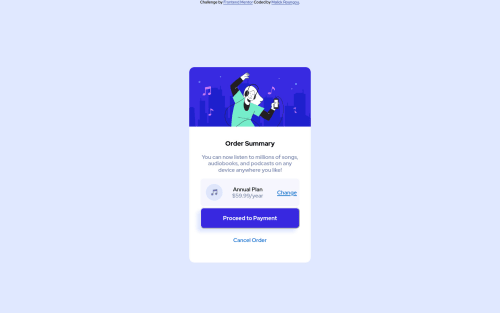Responsive order summary card

Solution retrospective
Hi, this is my second challenge on Front-end Mentor! Overall I think my implementation is close to the design. I wasn't able to add the overlay to the button nor "change" one you hovered on them. I'd appreciate a few pointers as to how I could implement that.
Also, though my code works, I'm sure it is not the most efficient/best way to go about things. I would also appreciate a few comments as to how I could make it better. Thanks ;)
Please log in to post a comment
Log in with GitHubCommunity feedback
- @Drougnov
Hello @mroungou, Great job on the implementation.
Although, here are some things you can improve.
- Your hover effect works fine both on the change link and the button but you need to change the color too. So add
color: hsl(245, 75%, 62%);andbackground-color: hsl(245, 75%, 62%);respectively in the hover rules. - You need to add a background pattern as the design required. Use
background: url(./images/pattern-background-desktop.svg) no-repeat, hsl(225, 100%, 94%); - Use
max-widthinstead ofwidthand rem instead of px for responsiveness. Then you wouldn't even need media queries for the card. - To fix accessibility issues, use
headermainfooteretc. instead ofdiv. And make sure to use at least one heading on a page. - Change the
h3toh1as you need at least one level one heading on a page.
If you need more information or help, feel free to ask or check out my solution. Have a good day my friend :)
Marked as helpful - Your hover effect works fine both on the change link and the button but you need to change the color too. So add
Join our Discord community
Join thousands of Frontend Mentor community members taking the challenges, sharing resources, helping each other, and chatting about all things front-end!
Join our Discord